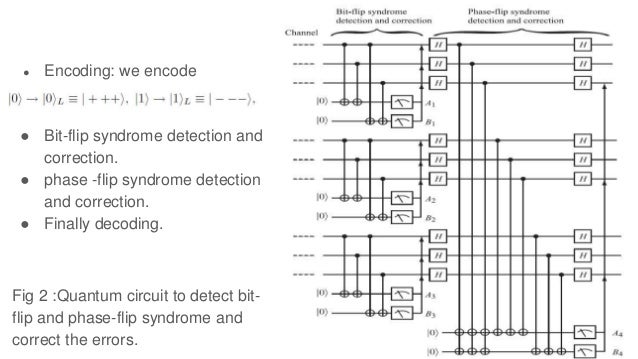

Our new approaches culminate in an additional tenfold or more reduction to the overhead needed for error correction on topological qubits compared to previous state of the art, opening a viable path toward scaling to a million qubits and beyond.Īdiabatic paths of Hamiltonians, symmetries of topological order, and automorphism codes On top of that, in these papers we introduce a new class of quantum error correction codes, called Floquet codes, which are particularly suited to topological qubits. Topological qubits promise lower error rates than conventional qubits, and as such can perform scalable quantum computation at lower overhead.
#Quantum error correcting codes how to#
In this post, we’ll share some exciting implications from our recent innovations toward scale-specifically how to perform quantum error correction in our topological quantum computation stack- published in the series of papers listed below. Therefore, any improvements on error correction have enormous positive ripple effects across the entire stack. However, quantum error correction also comes at a significant cost: depending on the quality of the physical qubits, error correction can increase the space requirements of a computation by a factor of several thousand and the time requirements more than tenfold. Without it, no known qubit technology can protect quantum states sufficiently long enough to perform a calculation that can deliver real-world impact. Indeed, such error correction needs to be at the heart of any scalable quantum system.

By encoding the state of a single logical qubit into many physical qubits, quantum error correction (QEC) has the ability to detect and correct most errors that occur on the physical qubits. A crucial technology to overcome this fragility, which is also used in classical digital computing, is error correction. One of the greatest challenges in building a quantum computer is that quantum states are intrinsically fragile and are quickly destroyed when a qubit couples to its environment, leading to noise.
#Quantum error correcting codes software#
At Azure Quantum, our full-stack approach and broad expertise across all areas of quantum computation allows us to drive innovation in this space through tight collaboration across theory, hardware, software and systems teams. However, our quest to deliver a general-purpose quantum computer capable of addressing industrial-scale problems will require innovation across every layer of the quantum stack, from materials at the nanoscale to algorithms and applications. In March of this year, we announced our demonstration of the underlying physics required to create a topological qubit-qubits that are theorized to be inherently more stable than existing ones without sacrificing size or speed. Technological innovation that enables scaling of quantum computing underpins the Microsoft Azure Quantum program. Learn more about this sequence of checks in the section “Unlocking a new class of quantum codes” below. Basic subjects as well as advanced theory and a survey of topics from cutting-edge research make this book invaluable both as a pedagogical introduction at the graduate level and as a reference for experts in quantum information science.This graphic shows the repeating three-step sequence of checks used in Floquet codes. Each circle represents a qubit, and a line between a pair of circles indicates that that check is measured on that time step. The colors indicate the type of operator measured in each check, either XX, YY, or ZZ, so that the type of check measured also changes with time. The book is not limited to a single approach, but reviews many different methods to control quantum errors, including topological codes, dynamical decoupling and decoherence-free subspaces. This comprehensive text, written by leading experts in the field, focuses on quantum error correction and thoroughly covers the theory as well as experimental and practical issues. Scalable quantum computers require a far-reaching theory of fault-tolerant quantum computation. To achieve large scale quantum computers and communication networks it is essential not only to overcome noise in stored quantum information, but also in general faulty quantum operations. Quantum computation and information is one of the most exciting developments in science and technology of the last twenty years.


 0 kommentar(er)
0 kommentar(er)
